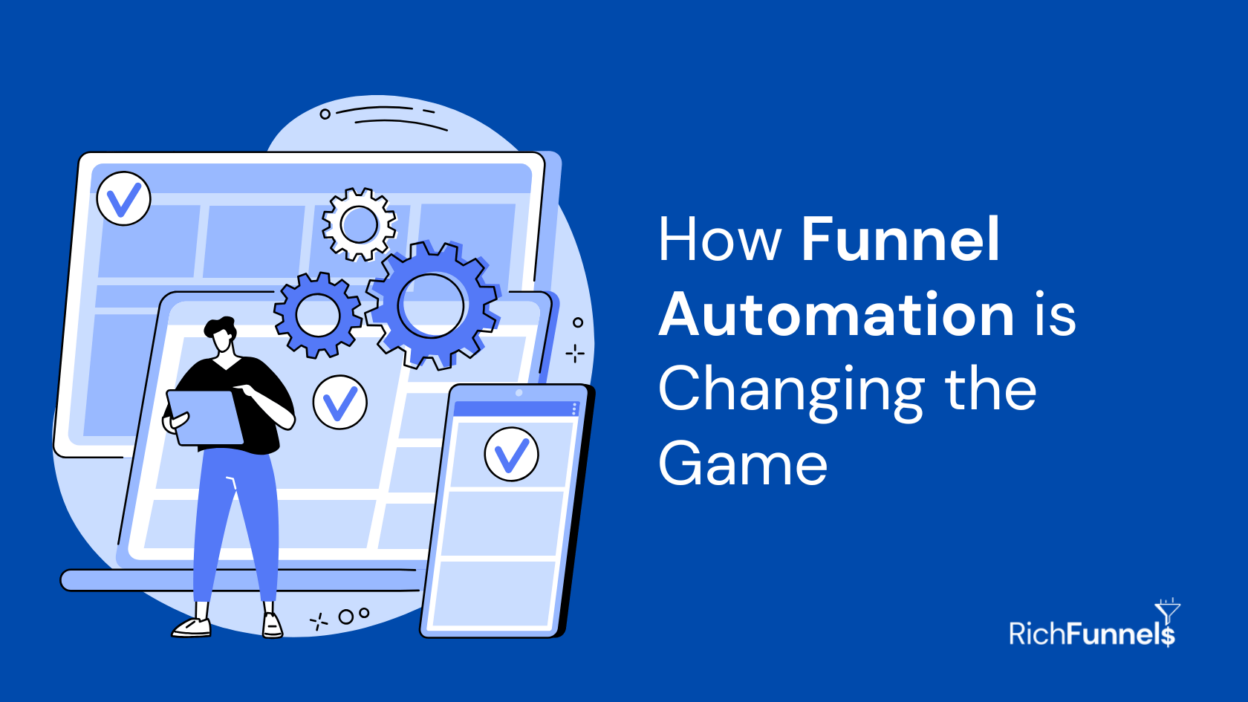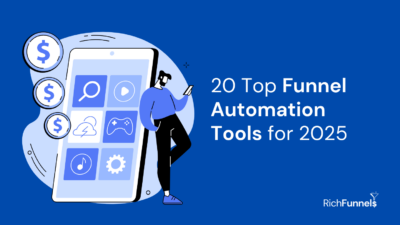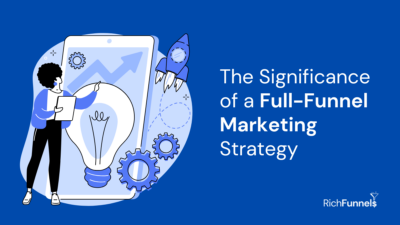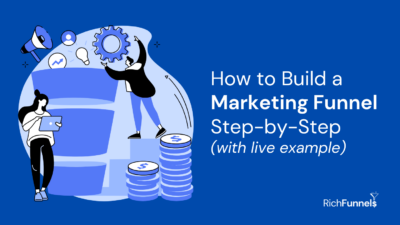- What is Funnel Automation?
- The Benefits of Funnel Automation
- Key Components of an Automated Funnel
- Top Funnel Automation Tools for 2025
- Implementing Funnel Automation: A Step-by-Step Guide
- Best Practices for Funnel Automation
- Measuring Success: KPIs for Automated Funnels
- Future Trends in Funnel Automation
What is Funnel Automation?
Funnel automation refers to the use of advanced technology and software to automate the various stages of a marketing or sales funnel. It’s a sophisticated approach that leverages AI-driven tools and algorithms to guide potential customers through their buying journey, from initial awareness to final purchase, with minimal manual intervention.
At its core, funnel automation is about creating a seamless, personalized experience for each prospect while simultaneously reducing the workload on your marketing and sales teams. It involves setting up a series of triggers, actions, and workflows that respond to user behavior in real-time, ensuring that each interaction is timely, relevant, and tailored to the individual’s needs and preferences.
Key aspects of funnel automation include:
- Automated Lead Scoring: Assigning values to leads based on their actions and characteristics, allowing for prioritization of high-potential prospects.
- Behavioral Triggers: Initiating specific actions or communications based on user behavior, such as visiting a particular webpage or abandoning a shopping cart.
- Multi-Channel Integration: Coordinating marketing efforts across various platforms including email, social media, SMS, and web interfaces.
- Dynamic Content Delivery: Serving personalized content based on user data, preferences, and stage in the buying journey.
- Predictive Analytics: Using historical data and AI to forecast future customer behavior and optimize marketing strategies accordingly.
By implementing funnel automation, businesses can create a more efficient, effective, and scalable marketing process that adapts to the needs of each individual prospect.
The Benefits of Funnel Automation
Funnel automation offers a multitude of advantages for businesses looking to optimize their marketing efforts:
- Increased Efficiency:
- Automates repetitive tasks, freeing up valuable time for strategic activities.
- Reduces human error in routine processes.
- Allows for 24/7 operation, ensuring no leads slip through the cracks.
- Improved Lead Nurturing:
- Delivers personalized content at scale, catering to individual preferences and behaviors.
- Maintains consistent communication with prospects throughout their journey.
- Allows for timely follow-ups based on prospect actions.
- Higher Conversion Rates:
- Guides prospects through the funnel with targeted messaging at each stage.
- Identifies and prioritizes high-quality leads for sales team focus.
- Reduces drop-offs by addressing pain points and objections proactively.
- Better Data Analysis:
- Provides real-time insights into funnel performance.
- Enables data-driven decision making through comprehensive analytics.
- Facilitates A/B testing and continuous optimization of marketing strategies.
- Cost-Effective:
- Reduces manual labor costs associated with lead management.
- Improves ROI by focusing resources on high-potential leads.
- Scales marketing efforts without proportional increase in costs.
- Enhanced Customer Experience:
- Provides timely, relevant information to prospects based on their specific needs.
- Ensures consistent brand messaging across all touchpoints.
- Enables personalized interactions that build stronger customer relationships.
- Improved Sales and Marketing Alignment:
- Bridges the gap between marketing and sales teams through shared data and insights.
- Ensures smooth handoff of qualified leads from marketing to sales.
- Provides sales teams with detailed prospect information for more effective conversations.
By leveraging these benefits, businesses can create more effective marketing campaigns, improve customer satisfaction, and ultimately drive growth and profitability.
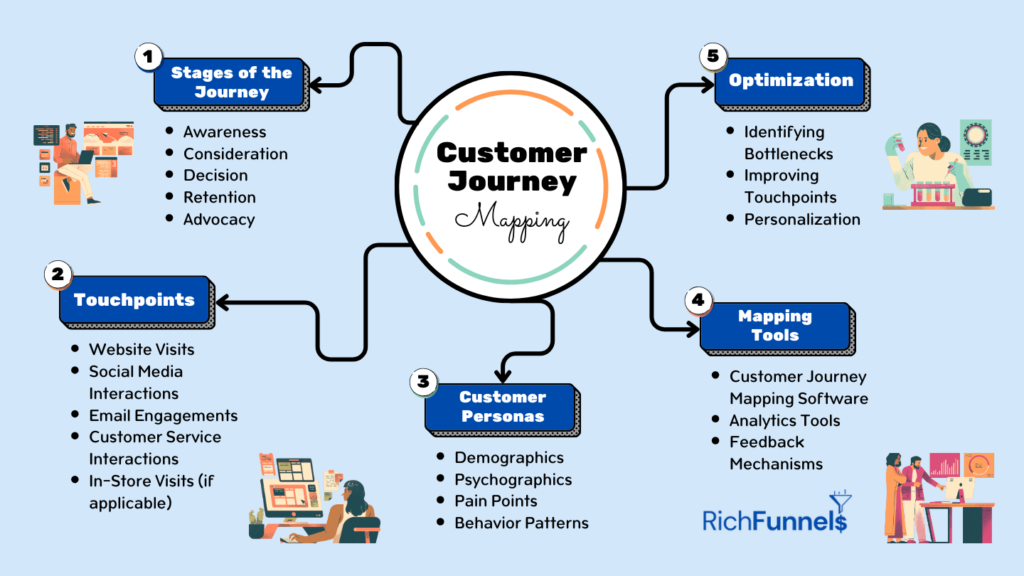
Key Components of an Automated Funnel
An effective automated funnel comprises several crucial components working in harmony:
- Lead Capture Mechanisms:
- Forms: Embedded on websites and landing pages to collect visitor information.
- Landing Pages: Dedicated pages designed to convert visitors into leads.
- Opt-in Pop-ups: Strategically timed pop-ups to encourage email sign-ups.
- Social Media Lead Ads: Targeted ads on platforms like Facebook and LinkedIn to capture leads directly.
- Email Marketing Automation:
- Welcome Series: Automated emails to introduce new subscribers to your brand.
- Drip Campaigns: Sequences of emails sent over time to nurture leads.
- Behavioral Triggers: Emails sent based on specific user actions or inactions.
- Segmentation: Dividing your email list based on demographics, behavior, or preferences for targeted messaging.
- CRM Integration:
- Data Synchronization: Ensuring seamless flow of information between marketing and sales platforms.
- Lead Scoring: Automated scoring of leads based on their interactions and profile.
- Activity Tracking: Monitoring and recording all prospect interactions across channels.
- Sales Alerts: Notifying sales teams when leads reach certain qualification thresholds.
- Content Personalization:
- Dynamic Web Content: Adjusting website content based on visitor data and behavior.
- Personalized Email Content: Tailoring email content to individual recipient preferences and history.
- Product Recommendations: Suggesting relevant products or services based on past interactions.
- Smart Forms: Pre-filling form fields with known information to improve user experience.
- Retargeting:
- Display Ads: Showing targeted ads to users who have previously interacted with your brand.
- Social Media Retargeting: Re-engaging prospects through platforms like Facebook and Instagram.
- Email Retargeting: Sending follow-up emails based on specific website interactions.
- Cross-Channel Retargeting: Coordinating retargeting efforts across multiple platforms for consistent messaging.
- Analytics and Reporting:
- Funnel Visualization: Graphical representation of prospect movement through the funnel.
- Conversion Tracking: Monitoring key conversion points throughout the customer journey.
- ROI Calculation: Measuring the return on investment for various marketing activities.
- Custom Dashboards: Creating tailored reports for different stakeholders in the organization.
- AI and Machine Learning Integration:
- Predictive Lead Scoring: Using AI to forecast which leads are most likely to convert.
- Chatbots: AI-powered conversational interfaces for instant customer support and lead qualification.
- Content Optimization: Using machine learning to determine the most effective content for each funnel stage.
- Behavioral Analysis: Identifying patterns in customer behavior to inform marketing strategies.
By integrating these components, businesses can create a comprehensive automated funnel that efficiently guides prospects from initial awareness to final conversion, while providing valuable insights for continuous improvement.
Top Funnel Automation Tools for 2025
As we move further into 2025, several funnel automation tools have emerged as leaders in the field. Here’s an in-depth look at the top contenders:
- HubSpot:
- Comprehensive all-in-one marketing automation platform
- Features: CRM, email marketing, content management, social media tools, and analytics
- Strengths: User-friendly interface, extensive integration capabilities, scalable for businesses of all sizes
- Best for: Companies looking for a complete inbound marketing solution
- Marketo:
- Advanced B2B marketing automation software
- Features: Lead management, email marketing, revenue attribution, and account-based marketing
- Strengths: Robust analytics, deep customization options, strong B2B focus
- Best for: Large enterprises with complex marketing needs
- Salesforce Pardot:
- B2B marketing automation platform integrated with Salesforce CRM
- Features: Lead nurturing, ROI reporting, sales alignment tools, and AI-powered insights
- Strengths: Seamless integration with Salesforce, advanced lead scoring, and grading
- Best for: Businesses already using Salesforce CRM or requiring deep sales and marketing alignment
- ActiveCampaign:
- Customer experience automation platform
- Features: Email marketing, marketing automation, CRM, and machine learning capabilities
- Strengths: Powerful automation builder, behavioral-based email marketing, affordable pricing tiers
- Best for: Small to medium-sized businesses looking for sophisticated automation at a reasonable price
- Keap (formerly Infusionsoft):
- All-in-one CRM, sales, and marketing platform for small businesses
- Features: Contact management, e-commerce tools, marketing automation, and reporting
- Strengths: Strong focus on small business needs, intuitive campaign builder
- Best for: Small businesses and solopreneurs requiring an integrated sales and marketing solution
- Omnisend:
- E-commerce focused marketing automation platform
- Features: Email marketing, SMS marketing, push notifications, and advanced segmentation
- Strengths: Deep integration with e-commerce platforms, omnichannel campaign coordination
- Best for: Online retailers looking to automate and personalize their marketing efforts
- Autopilot:
- Visual marketing automation software
- Features: Multi-channel journeys, lead scoring, A/B testing, and collaboration tools
- Strengths: Intuitive drag-and-drop interface, strong focus on customer journey mapping
- Best for: Businesses that prioritize visual workflow creation and team collaboration
- Drip:
- E-commerce CRM and marketing automation platform
- Features: Advanced segmentation, personalization tools, multi-channel marketing
- Strengths: Deep e-commerce integrations, powerful workflow automation
- Best for: E-commerce businesses looking for advanced personalization and automation capabilities
When choosing a funnel automation tool, consider factors such as your business size, industry, specific needs, budget, and existing tech stack. Many of these platforms offer free trials, allowing you to test their features before committing to a subscription.
Implementing Funnel Automation: A Step-by-Step Guide
Implementing funnel automation requires careful planning and execution. Here’s a detailed guide to get you started:
- Define Your Goals:
- Identify specific, measurable objectives for your automated funnel
- Example goals: Increase lead generation by 30%, improve email open rates by 15%, reduce customer acquisition cost by 20%
- Align automation goals with overall business objectives
- Map Your Customer Journey:
- Create a detailed customer journey map
- Identify key touchpoints and potential pain points
- Define the ideal path from awareness to purchase
- Determine appropriate messaging and content for each stage
- Choose the Right Tools:
- Assess your current tech stack and identify gaps
- Research and compare automation platforms based on your needs
- Consider factors like scalability, integration capabilities, and pricing
- Test drive potential solutions through free trials or demos
- Create Compelling Content:
- Develop a content strategy aligned with your funnel stages
- Create various content types: blog posts, ebooks, webinars, case studies, etc.
- Ensure content addresses customer pain points and questions
- Optimize content for SEO and conversions
- Set Up Triggers and Workflows:
- Define rules for automated actions based on user behavior
- Create email sequences for different segments and funnel stages
- Set up lead scoring criteria to prioritize high-potential prospects
- Implement behavioral triggers for timely, relevant communications
- Integrate Your Systems:
- Connect your CRM with your marketing automation platform
- Ensure seamless data flow between systems
- Set up proper tracking and attribution
- Test Your Funnel:
- Conduct thorough testing of all automated elements
- Perform A/B tests on key components like email subject lines and CTAs
- Test the entire funnel from a user’s perspective
- Identify and fix any bugs or issues
- Train Your Team:
- Provide comprehensive training on the new automation tools
- Ensure all team members understand their roles in the automated process
- Create documentation and standard operating procedures
- Launch and Monitor:
- Roll out your automated funnel, starting with a small segment if possible
- Closely monitor key metrics and KPIs
- Be prepared to make quick adjustments based on initial results
- Continuously Optimize:
- Regularly analyze funnel performance data
- Identify bottlenecks and drop-off points
- Continuously test and refine different elements of your funnel
- Stay updated on new features and best practices in funnel automation
Remember, implementing funnel automation is an ongoing process. Be prepared to iterate and improve your funnel over time based on data and customer feedback.
Best Practices for Funnel Automation
To maximize the effectiveness of your automated funnel, consider these best practices:
- Segment Your Audience:
- Divide your audience based on demographics, behavior, and preferences
- Create targeted campaigns for each segment
- Use dynamic content to personalize messaging
- Regularly update and refine your segments based on new data
- Maintain a Human Touch:
- Balance automation with personalized interactions
- Use automation to identify opportunities for human intervention
- Incorporate personal touches in automated communications (e.g., personalized video messages)
- Provide easy ways for prospects to reach a human when needed
- Ensure Data Privacy Compliance:
- Stay up-to-date with regulations like GDPR, CCPA, and other relevant laws
- Implement proper data collection and storage practices
- Provide clear opt-in and opt-out options
- Regularly audit your data handling processes
- Regularly Update Content:
- Keep your automated messages fresh and relevant
- Update content to reflect current trends and customer needs
- Regularly review and refresh evergreen content
- Use dynamic content to ensure relevance across different segments
- Monitor and Adjust:
- Stay agile and adapt to changing customer behaviors
- Regularly review funnel performance metrics
- Be prepared to make quick adjustments based on data insights
- Encourage feedback from both customers and team members
- Focus on Quality Over Quantity:
- Prioritize sending relevant, valuable content over frequent communications
- Use lead scoring to focus on high-quality prospects
- Avoid overwhelming your audience with too many touchpoints
- Implement Progressive Profiling:
- Gradually collect information about prospects over time
- Use smart forms that adapt based on known information
- Leverage this data to provide increasingly personalized experiences
- Optimize for Mobile:
- Ensure all elements of your funnel are mobile-friendly
- Design emails and landing pages with mobile users in mind
- Consider implementing SMS marketing for immediate engagement
- Use Multi-Channel Approach:
- Coordinate your messaging across various channels (email, social media, web, etc.)
- Provide a consistent experience across all touchpoints
- Allow prospects to engage on their preferred platforms
- Implement Lead Nurturing Strategies:
- Develop targeted nurture campaigns for different segments and funnel stages
- Use behavioral triggers to deliver timely, relevant content
- Gradually build trust and demonstrate value throughout the customer journey
- Leverage Social Proof:
- Incorporate testimonials, case studies, and reviews in your automated communications
- Use dynamic content to showcase relevant social proof based on prospect characteristics
- Implement automated requests for reviews and testimonials from satisfied customers
- Continuous Learning and Improvement:
- Stay updated on the latest trends and technologies in funnel automation
- Regularly train your team on best practices and new features
- Encourage a culture of experimentation and data-driven decision making
By following these best practices, you can create a more effective, efficient, and customer-centric automated funnel that drives results and provides a superior experience for your prospects and customers.
Measuring Success: KPIs for Automated Funnels
To ensure the effectiveness of your automated funnel, it’s crucial to track the right Key Performance Indicators (KPIs). Here’s an in-depth look at essential metrics to monitor:
- Conversion Rate:
- Definition: The percentage of leads that complete a desired action (e.g., make a purchase, sign up for a trial)
- How to measure: (Number of conversions / Total number of visitors) x 100
- Why it matters: Indicates the overall effectiveness of your funnel in turning prospects into customers
- How to improve: A/B testing, optimizing landing pages, refining messaging
- Customer Acquisition Cost (CAC):
- Definition: The total cost of acquiring a new customer
- How to measure: Total marketing and sales costs / Number of new customers acquired
- Why it matters: Helps determine the efficiency of your marketing spend
- How to improve: Optimize ad spend, improve targeting, enhance funnel efficiency
- Customer Lifetime Value (CLV):
- Definition: The total revenue a business can expect from a single customer account throughout the business relationship
- How to measure: (Average purchase value x Average purchase frequency rate x Average customer lifespan)
- Why it matters: Helps in determining how much to invest in acquiring and retaining customers
- How to improve: Increase customer retention, upsell and cross-sell strategies, improve customer experience
- Email Open and Click-Through Rates:
- Definition: The percentage of recipients who open your emails and click on links within them
- How to measure: (Number of opens or clicks / Number of delivered emails) x 100
- Why it matters: Indicates the effectiveness of your email marketing efforts
- How to improve: Optimize subject lines, improve email content, segment your list
- Return on Investment (ROI):
- Definition: The profitability of your marketing efforts
- How to measure: (Gain from investment – Cost of investment) / Cost of investment
- Why it matters: Helps determine which marketing activities are most profitable
- How to improve: Focus on high-performing channels, optimize underperforming campaigns
- Lead Velocity Rate (LVR):
- Definition: The month-over-month growth in qualified leads
- How to measure: ((This month’s qualified leads – Last month’s qualified leads) / Last month’s qualified leads) x 100
- Why it matters: Indicates the speed at which your business is acquiring new potential customers
- How to improve: Expand marketing efforts, improve lead qualification processes
- Time to Conversion:
- Definition: The average time it takes for a lead to convert into a customer
- How to measure: Sum of all conversion times / Number of conversions
- Why it matters: Helps identify bottlenecks in your funnel and opportunities for optimization
- How to improve: Streamline the buying process, provide timely and relevant information
- Funnel Velocity:
- Definition: The speed at which leads move through your funnel
- How to measure: Track time spent at each stage of the funnel
- Why it matters: Identifies stages where leads are getting stuck or dropping off
- How to improve: Optimize content and messaging at each stage, remove friction points
- Engagement Rate:
- Definition: The level of interaction prospects have with your content and communications
- How to measure: Varies by channel (e.g., social media likes/shares, email click-throughs, website time on page)
- Why it matters: Indicates how well your content resonates with your audience
- How to improve: Create more relevant and valuable content, improve targeting
- Churn Rate:
- Definition: The rate at which customers stop doing business with you
- How to measure: (Number of customers lost in a period / Number of customers at start of period) x 100
- Why it matters: High churn can indicate problems with product, service, or customer experience
- How to improve: Enhance customer onboarding, improve product/service quality, implement retention strategies
- Net Promoter Score (NPS):
- Definition: A measure of customer satisfaction and loyalty
- How to measure: Survey customers on likelihood to recommend (0-10 scale), calculate percentage of promoters (9-10) minus detractors (0-6)
- Why it matters: Indicates overall customer satisfaction and potential for word-of-mouth growth
- How to improve: Address issues raised by detractors, enhance overall customer experience
- Attribution Modeling:
- Definition: Assigning credit to marketing touchpoints in the customer journey
- How to measure: Varies based on model chosen (e.g., first-touch, last-touch, multi-touch)
- Why it matters: Helps understand which marketing efforts are most effective in driving conversions
- How to improve: Experiment with different attribution models, optimize high-impact touchpoints
When measuring these KPIs, it’s important to:
- Set benchmarks and goals for each metric
- Regularly review and analyze trends over time
- Compare performance across different segments and campaigns
- Use the insights gained to continuously refine and optimize your funnel
Remember, while these metrics are important, they should always be considered in the context of your specific business goals and customer journey. The most valuable KPIs will vary depending on your industry, business model, and current priorities.
Future Trends in Funnel Automation
As we look ahead, several emerging trends are set to shape the future of funnel automation. Here’s an in-depth exploration of what to expect:
- AI-Powered Personalization:
- Advanced algorithms for hyper-personalized experiences
- Real-time content adaptation based on user behavior and preferences
- Predictive analytics to anticipate customer needs and actions
- AI-driven product recommendations and dynamic pricing
- Voice-Activated Funnels:
- Integration with smart speakers and voice assistants
- Voice-optimized content and search strategies
- Voice-based customer service and support
- Voice commerce capabilities
- Augmented Reality (AR) in Funnels:
- Immersive product experiences within the funnel
- AR-powered virtual try-ons and product demonstrations
- Interactive AR-enhanced educational content
- Location-based AR marketing experiences
- Blockchain for Data Security:
- Enhanced protection of customer data in automated systems
- Transparent and secure data collection and storage practices
- Blockchain-based loyalty programs and rewards
- Decentralized customer identity management
- Cross-Channel Automation:
- Seamless integration across multiple platforms and devices
- Unified customer profiles across all touchpoints
- Consistent messaging and experiences across channels
- Advanced attribution modeling for cross-channel campaigns
- Emotional AI and Sentiment Analysis:
- Understanding and responding to customer emotions in real-time
- Adapting communication style based on emotional context
- Predictive emotional modeling for personalized experiences
- Emotion-based segmentation and targeting
- Conversational Marketing at Scale:
- Advanced chatbots and virtual assistants throughout the funnel
- Natural language processing for more human-like interactions
- Integration of chatbots with CRM and other business systems
- Voice-enabled conversational interfaces
- Predictive Lead Scoring and Qualification:
- AI-driven models to predict lead quality and likelihood to convert
- Real-time lead scoring adjustments based on behavior
- Automated lead routing and prioritization
- Predictive churn analysis and prevention strategies
- Video Personalization:
- Dynamically generated personalized video content
- Interactive video experiences within the funnel
- AI-powered video analytics for engagement insights
- Live video integration in automated funnels
- Privacy-First Marketing:
- Adapting to a cookieless future with new tracking and personalization methods
- Increased focus on first-party data collection and activation
- Privacy-enhancing technologies (PETs) in marketing automation
- Transparent data practices as a competitive advantage
- IoT Integration:
- Leveraging data from Internet of Things (IoT) devices for personalization
- IoT-triggered marketing actions and communications
- Predictive maintenance and support based on IoT data
- Connected packaging and product-based marketing automation
- Quantum Computing in Marketing:
- Exponentially faster data processing and analysis
- Complex modeling and simulation for campaign optimization
- Advanced encryption for data security
- Solving complex optimization problems in real-time
- Neuromarketing Techniques:
- Using neuroscience insights to optimize funnel design
- Eye-tracking and biometric data for UX optimization
- Subconscious trigger identification for more effective messaging
- Ethical considerations in applying neuroscience to marketing
- Sustainable and Ethical Automation:
- Energy-efficient automation processes and green hosting
- Ethical AI practices in marketing automation
- Transparency in automated decision-making processes
- Automation supporting corporate social responsibility initiatives
- Micro-Moment Marketing:
- Identifying and capitalizing on brief, intent-rich moments
- Real-time, context-aware micro-targeting
- Integration of micro-moments into broader customer journey mapping
- Automated responses to micro-moments across channels
As these trends evolve, marketers will need to stay agile, continuously learning and adapting their strategies. The future of funnel automation promises more personalized, efficient, and effective marketing experiences for both businesses and consumers. However, it also brings challenges in terms of data privacy, ethical considerations, and the need for increasingly sophisticated technical skills.
To prepare for these future trends:
- Stay informed about emerging technologies and their potential applications in marketing
- Invest in ongoing training and skill development for your team
- Prioritize data privacy and ethical marketing practices
- Experiment with new technologies and approaches on a small scale before full implementation
- Foster a culture of innovation and adaptability within your organization
By embracing these future trends thoughtfully and strategically, businesses can create more engaging, effective, and customer-centric marketing funnels that drive growth and build lasting relationships with their audience.


